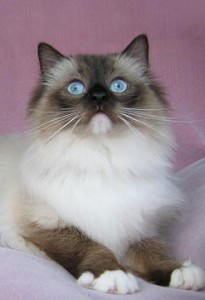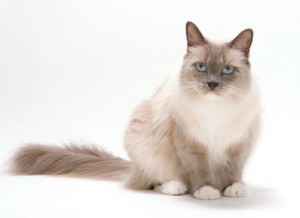All About Ragdoll Cats

The Ragdoll cat is a semi-longhaired cat breed with blue eyes and a distinct colorpoint coat.
Ragdoll cats are large and have a soft and silky fur coat.
They were developed by American breeder Ann Baker, and are best known for their docile and placid temperament and affectionate nature.
Why are they called Ragdolls?
The first ragdoll cats were named so after they would go limp whenever lifted up.
Ragdoll Cats Temperament and Characteristics
The Ragdoll Cat is one of the largest domesticated cat breeds with a sturdy body, large frame and proportionate legs.
A fully-grown femaleweighs from 8 pounds (3.6 kg) to 15 pounds (6.8 kg).
Males are substantially larger, ranging from 12 pounds (5.4 kg) to 20 pounds (9.1 kg) or more.
The genes for point coloration are also responsible for the blue eyes of the Ragdoll.
Intense shades of blue are liked best in the cat shows.
Though the Ragdoll cat breed has a plush, soft coat, this coat consists mainly of long guard hairs, while the lack of a dense undercoat results in, according to the Cat Fanciers’ Association, “reduced shedding and matting.”
Mitted Ragdoll cats will often be confused for Birmans.
The easiest way to tell the difference between the two is by size (the Ragdoll being obviously larger) and chin color (Ragdolls have white chins, while Birmans have colored chins).
The docile and floppy nature of the Ragdoll is a characteristic thought to be passed down from the Persian and Siamese breed.
There are contrary statements on whether this trait might be the result of genetic mutation.
The extreme docility of some individuals have led to the myth that Ragdolls are pain-resistant.
Some breeders in Britain have tried to breed away from the limpness due to concerns that extreme docility “might not be in the best interests of the cat.”
There have been multiple reports of ragdolls nonchalantly approaching moving cars and vicious dogs and getting hurt. Breed standards describe the Ragdoll Cat as affectionate, intelligent, relaxed in temperament, gentle and easy to handle.
Ragdoll Cat Coloring

The Ragdoll has a “pointed” coat color, meaning that like the Siamese cats, the extremities are darker than the torso. Ragdolls come in six different colors – seal, (brown points); blue (gray points); flame (orange points); and their corresponding “dilutes” or pastel shades – chocolate, lilac and cream points.
A “tortie-point” is a mottled variation, and would have any 2 of these colors, and is always female. A lynxpoint includes the striping found on a classic tabby cat but only visible to varying degrees on the points or extremities.
Did you know that Ragdoll kittens are born all white?
They gradually darken and have representative color at 8 – 10 weeks and full color and coat at 3 – 4 years. There are three different patterns:
COLORpoint – “Points” (face, ears, tail legs) are dark with lighter torso.
MITTED – Points are darker than torso, but front feet also have white mittens, and back legs are white to the hocks. A “mitted” Ragdoll may have a white blaze, line or splotch on its face between the eyes and sometimes down to the nose, and should have a “belly stripe” (white stripe that runs from the chin to the genitals) and a white chin.
BI-COLOR — Still a “pointed” cat, but on all the legs the “points” are obscured by white which goes up to the knee or chest in front and up to the top of the back legs. A bi-color Ragdoll has a white inverted ‘V’ on the face, with a white abdomen and sometimes white patches on the back. Excessive amounts of white, or “high white,” on a bicolor is known as the Van pattern, although this doesn’t occur nearly as often as the other patterns.
Want to find a home for your ragdoll kittens? Or adopt a ragdoll cat?
Check out our free cat adoption classifieds>>>
Thinking of adopting a Maine Coon cat? Read this article first!
Source: http://en.wikipedia.org/wiki/Ragdoll

I would thoroughly recommend a Ragdoll cat to anyone. I’ve been owned by a Ragdoll for just over a year now and I can say that I have enjoyed every minute of it. He is sweet and laid back, but also occasionally hilarious!
Just a correction in your post, if you don’t mind? You say “A “tortie-point” is a mottled variation, and would have any 2 of these colors, and is always female”.
Tortie is actually made up of three colors, white, red and the base color – blue or seal etc. The colors may be “mottled” or can be very distinct patches. And there have been male Torties on record, they are just very rare and are usually sterile.